Distance Between Atlanta & Savannah

Electricity is the set of physical phenomena associated with the presence and move of affair that has a property of electric charge. Electricity is related to magnetism, both being part of the phenomenon of electromagnetism, as described by Maxwell'southward equations. Various common phenomena are related to electricity, including lightning, static electricity, electric heating, electric discharges and many others.
The presence of an electrical charge, which tin be either positive or negative, produces an electric field. The movement of electrical charges is an electric current and produces a magnetic field.
When a charge is placed in a location with a non-zero electric field, a force will deed on it. The magnitude of this force is given by Coulomb's law. If the charge moves, the electric field would be doing piece of work on the electric charge. Thus nosotros tin can speak of electric potential at a certain indicate in space, which is equal to the work done past an external agent in conveying a unit of positive accuse from an arbitrarily chosen reference point to that point without any dispatch and is typically measured in volts.
Electricity is at the center of many modernistic technologies, being used for:
- Electric power where electric current is used to energise equipment;
- Electronics which deals with electric circuits that involve agile electrical components such as vacuum tubes, transistors, diodes and integrated circuits, and associated passive interconnection technologies.
Electrical phenomena have been studied since antiquity, though progress in theoretical agreement remained tedious until the seventeenth and eighteenth centuries. The theory of electromagnetism was adult in the 19th century, and by the stop of that century electricity was existence put to industrial and residential use by electric engineers. The rapid expansion in electric technology at this time transformed industry and society, becoming a driving strength for the Second Industrial Revolution. Electricity's extraordinary versatility means it can exist put to an almost limitless prepare of applications which include transport, heating, lighting, communications, and computation. Electrical power is at present the backbone of modern industrial society.[1]
History

Thales, the primeval known researcher into electricity
Long before whatsoever noesis of electricity existed, people were aware of shocks from electric fish. Ancient Egyptian texts dating from 2750 BCE referred to these fish every bit the "Thunderer of the Nile", and described them as the "protectors" of all other fish. Electrical fish were over again reported millennia later by aboriginal Greek, Roman and Arabic naturalists and physicians.[ii] Several ancient writers, such as Pliny the Elder and Scribonius Largus, attested to the numbing result of electrical shocks delivered by electric catfish and electrical rays, and knew that such shocks could travel forth conducting objects.[3] Patients with ailments such as gout or headache were directed to affect electric fish in the hope that the powerful jolt might cure them.[4]
Aboriginal cultures around the Mediterranean knew that certain objects, such as rods of bister, could be rubbed with cat'due south fur to attract light objects like feathers. Thales of Miletus fabricated a series of observations on static electricity effectually 600 BCE, from which he believed that friction rendered amber magnetic, in dissimilarity to minerals such equally magnetite, which needed no rubbing.[v] [6] [7] [eight] Thales was wrong in believing the attraction was due to a magnetic consequence, only later science would show a link between magnetism and electricity. Co-ordinate to a controversial theory, the Parthians may have had cognition of electroplating, based on the 1936 discovery of the Baghdad Bombardment, which resembles a galvanic jail cell, though it is uncertain whether the artifact was electrical in nature.[9]
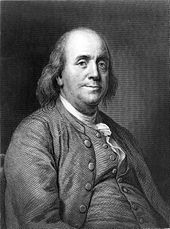
Benjamin Franklin conducted extensive enquiry on electricity in the 18th century, as documented by Joseph Priestley (1767) History and Present Condition of Electricity, with whom Franklin carried on extended correspondence.
Electricity would remain little more an intellectual curiosity for millennia until 1600, when the English language scientist William Gilbert wrote De Magnete, in which he made a careful study of electricity and magnetism, distinguishing the lodestone upshot from static electricity produced past rubbing bister.[5] He coined the New Latin word electricus ("of amber" or "similar bister", from ἤλεκτρον, elektron, the Greek give-and-take for "amber") to refer to the property of attracting small objects after being rubbed.[x] This association gave ascension to the English words "electric" and "electricity", which made their outset appearance in print in Thomas Browne's Pseudodoxia Epidemica of 1646.[11]
Further work was conducted in the 17th and early on 18th centuries past Otto von Guericke, Robert Boyle, Stephen Grey and C. F. du Fay.[12] Afterwards in the 18th century, Benjamin Franklin conducted extensive research in electricity, selling his possessions to fund his piece of work. In June 1752 he is reputed to have attached a metal key to the bottom of a dampened kite string and flown the kite in a storm-threatened sky.[13] A succession of sparks jumping from the central to the back of his manus showed that lightning was indeed electrical in nature.[xiv] He also explained the apparently paradoxical behavior[fifteen] of the Leyden jar as a device for storing large amounts of electrical accuse in terms of electricity consisting of both positive and negative charges.[12]

Michael Faraday's discoveries formed the foundation of electric motor technology
In 1775, Hugh Williamson reported a series of experiments to the Royal Order on the shocks delivered by the electrical eel;[xvi] that aforementioned year the surgeon and anatomist John Hunter described the construction of the fish's electric organs.[17] [18] In 1791, Luigi Galvani published his discovery of bioelectromagnetics, demonstrating that electricity was the medium by which neurons passed signals to the muscles.[19] [20] [12] Alessandro Volta's bombardment, or voltaic pile, of 1800, made from alternating layers of zinc and copper, provided scientists with a more than reliable source of electric energy than the electrostatic machines previously used.[19] [20] The recognition of electromagnetism, the unity of electrical and magnetic phenomena, is due to Hans Christian Ørsted and André-Marie Ampère in 1819–1820. Michael Faraday invented the electrical motor in 1821, and Georg Ohm mathematically analysed the electric excursion in 1827.[xx] Electricity and magnetism (and light) were definitively linked by James Clerk Maxwell, in particular in his "On Physical Lines of Force" in 1861 and 1862.[21]
While the early 19th century had seen rapid progress in electrical science, the late 19th century would see the greatest progress in electrical engineering. Through such people every bit Alexander Graham Bell, Ottó Bláthy, Thomas Edison, Galileo Ferraris, Oliver Heaviside, Ányos Jedlik, William Thomson, 1st Businesswoman Kelvin, Charles Algernon Parsons, Werner von Siemens, Joseph Swan, Reginald Fessenden, Nikola Tesla and George Westinghouse, electricity turned from a scientific marvel into an essential tool for modern life.
In 1887, Heinrich Hertz[22] : 843–44 [23] discovered that electrodes illuminated with ultraviolet low-cal create electric sparks more hands. In 1905, Albert Einstein published a paper that explained experimental data from the photoelectric consequence equally beingness the consequence of light energy being carried in detached quantized packets, energising electrons. This discovery led to the quantum revolution. Einstein was awarded the Nobel Prize in Physics in 1921 for "his discovery of the constabulary of the photoelectric event".[24] The photoelectric event is also employed in photocells such every bit can be found in solar panels and this is frequently used to make electricity commercially.
The kickoff solid-state device was the "cat's-whisker detector" first used in the 1900s in radio receivers. A whisker-like wire is placed lightly in contact with a solid crystal (such as a germanium crystal) to detect a radio betoken by the contact junction effect.[25] In a solid-country component, the current is confined to solid elements and compounds engineered specifically to switch and amplify it. Current menstruum tin exist understood in two forms: as negatively charged electrons, and as positively charged electron deficiencies chosen holes. These charges and holes are understood in terms of quantum physics. The building textile is most often a crystalline semiconductor.[26] [27]
Solid-state electronics came into its own with the emergence of transistor applied science. The first working transistor, a germanium-based signal-contact transistor, was invented by John Bardeen and Walter Houser Brattain at Bell Labs in 1947,[28] followed by the bipolar junction transistor in 1948.[29] These early transistors were relatively bulky devices that were difficult to manufacture on a mass-production basis.[30] : 168 They were followed by the silicon-based MOSFET (metal-oxide-semiconductor field-effect transistor, or MOS transistor), invented by Mohamed M. Atalla and Dawon Kahng at Bell Labs in 1959.[31] [32] [33] It was the get-go truly meaty transistor that could exist miniaturised and mass-produced for a wide range of uses,[30] : 165, 179 leading to the silicon revolution.[34] Solid-country devices started condign prevalent from the 1960s, with the transition from vacuum tubes to semiconductor diodes, transistors, integrated circuit (IC) chips, MOSFETs, and light-emitting diode (LED) engineering science.
The most mutual electronic device is the MOSFET,[32] [35] which has go the nearly widely manufactured device in history.[36] Common solid-state MOS devices include microprocessor fries[37] and semiconductor retention.[38] [39] A special blazon of semiconductor memory is flash memory, which is used in USB flash drives and mobile devices, too every bit solid-state drive (SSD) engineering science to replace mechanically rotating magnetic disc hd drive (HDD) technology.
Concepts
Electrical charge
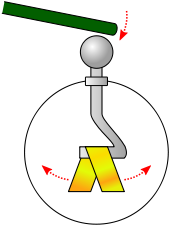
The presence of accuse gives rise to an electrostatic forcefulness: charges exert a force on each other, an outcome that was known, though not understood, in antiquity.[22] : 457 A lightweight ball suspended past a fine thread can be charged past touching it with a drinking glass rod that has itself been charged by rubbing with a cloth. If a similar brawl is charged by the same glass rod, information technology is found to repel the beginning: the charge acts to force the two balls apart. Two balls that are charged with a rubbed amber rod too repel each other. Withal, if 1 ball is charged by the glass rod, and the other by an amber rod, the ii balls are found to concenter each other. These phenomena were investigated in the late eighteenth century past Charles-Augustin de Coulomb, who deduced that charge manifests itself in two opposing forms. This discovery led to the well-known axiom: like-charged objects repel and opposite-charged objects concenter.[22]
The force acts on the charged particles themselves, hence charge has a tendency to spread itself as evenly as possible over a conducting surface. The magnitude of the electromagnetic force, whether bonny or repulsive, is given by Coulomb's police force, which relates the forcefulness to the product of the charges and has an inverse-square relation to the distance between them.[40] [41] : 35 The electromagnetic force is very strong, 2nd simply in force to the strong interaction,[42] merely different that forcefulness it operates over all distances.[43] In comparison with the much weaker gravitational force, the electromagnetic force pushing two electrons apart is 1042 times that of the gravitational attraction pulling them together.[44]
Charge originates from certain types of subatomic particles, the most familiar carriers of which are the electron and proton. Electrical charge gives rise to and interacts with the electromagnetic strength, ane of the four fundamental forces of nature. Experiment has shown charge to be a conserved quantity, that is, the internet charge within an electrically isolated system will e'er remain constant regardless of any changes taking place within that system.[45] Inside the organization, charge may be transferred between bodies, either by direct contact, or by passing forth a conducting fabric, such as a wire.[41] : 2–v The informal term static electricity refers to the internet presence (or 'imbalance') of charge on a body, usually caused when different materials are rubbed together, transferring charge from one to the other.
The charge on electrons and protons is opposite in sign, hence an corporeality of accuse may be expressed equally being either negative or positive. By convention, the charge carried past electrons is accounted negative, and that by protons positive, a custom that originated with the work of Benjamin Franklin.[46] The amount of charge is usually given the symbol Q and expressed in coulombs;[47] each electron carries the same charge of approximately −1.6022×ten−19 coulomb. The proton has a accuse that is equal and opposite, and thus +ane.6022×10−nineteen coulomb. Charge is possessed not simply past affair, merely also past antimatter, each antiparticle begetting an equal and reverse accuse to its corresponding particle.[48]
Charge can be measured by a number of means, an early instrument being the aureate-leafage electroscope, which although still in utilise for classroom demonstrations, has been superseded by the electronic electrometer.[41] : 2–v
Electric current
The motion of electric charge is known as an electric electric current, the intensity of which is usually measured in amperes. Current can consist of any moving charged particles; most commonly these are electrons, but any charge in motion constitutes a current. Electrical current can menstruum through some things, electrical conductors, but will not flow through an electrical insulator.[49]
By historical convention, a positive current is defined equally having the same management of menses equally any positive charge it contains, or to flow from the most positive function of a circuit to the most negative part. Current defined in this mode is chosen conventional current. The motion of negatively charged electrons effectually an electric circuit, one of the most familiar forms of current, is thus deemed positive in the contrary direction to that of the electrons.[l] However, depending on the weather, an electrical current can consist of a flow of charged particles in either management, or fifty-fifty in both directions at once. The positive-to-negative convention is widely used to simplify this situation.
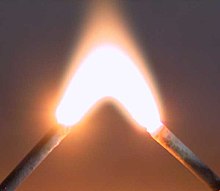
An electric arc provides an energetic demonstration of electric electric current
The process by which electric current passes through a textile is termed electric conduction, and its nature varies with that of the charged particles and the textile through which they are travelling. Examples of electric currents include metallic conduction, where electrons flow through a conductor such as metal, and electrolysis, where ions (charged atoms) flow through liquids, or through plasmas such equally electrical sparks. While the particles themselves can move quite slowly, sometimes with an average drift velocity only fractions of a millimetre per 2nd,[41] : 17 the electrical field that drives them itself propagates at close to the speed of calorie-free, enabling electrical signals to pass speedily along wires.[51]
Electric current causes several appreciable effects, which historically were the means of recognising its presence. That water could be decomposed by the electric current from a voltaic pile was discovered by Nicholson and Carlisle in 1800, a process now known as electrolysis. Their work was profoundly expanded upon by Michael Faraday in 1833. Current through a resistance causes localised heating, an issue James Prescott Joule studied mathematically in 1840.[41] : 23–24 One of the most important discoveries relating to current was fabricated accidentally by Hans Christian Ørsted in 1820, when, while preparing a lecture, he witnessed the current in a wire agonizing the needle of a magnetic compass.[52] He had discovered electromagnetism, a fundamental interaction between electricity and magnetics. The level of electromagnetic emissions generated past electric arcing is loftier enough to produce electromagnetic interference, which can be detrimental to the workings of adjacent equipment.[53]
In engineering or household applications, current is often described as existence either direct current (DC) or alternate current (Ac). These terms refer to how the electric current varies in time. Direct current, as produced by example from a battery and required past near electronic devices, is a unidirectional flow from the positive part of a circuit to the negative.[54] : 11 If, as is most mutual, this period is carried by electrons, they will be travelling in the contrary direction. Alternating current is whatever electric current that reverses direction repeatedly; about always this takes the form of a sine wave.[54] : 206–07 Alternating current thus pulses back and along within a conductor without the charge moving any net distance over time. The time-averaged value of an alternate current is zero, simply information technology delivers free energy in starting time one management, and then the reverse. Alternating current is affected by electrical backdrop that are not observed under steady country direct current, such as inductance and capacitance.[54] : 223–25 These properties yet can get important when circuitry is subjected to transients, such equally when first energised.
Electric field
The concept of the electric field was introduced past Michael Faraday. An electrical field is created by a charged trunk in the infinite that surrounds it, and results in a force exerted on whatsoever other charges placed within the field. The electrical field acts between 2 charges in a similar style to the way that the gravitational field acts between two masses, and like it, extends towards infinity and shows an inverse square relationship with distance.[43] Yet, at that place is an of import deviation. Gravity always acts in attraction, drawing two masses together, while the electric field can outcome in either attraction or repulsion. Since big bodies such as planets generally carry no cyberspace accuse, the electrical field at a distance is usually naught. Thus gravity is the dominant force at altitude in the universe, despite being much weaker.[44]
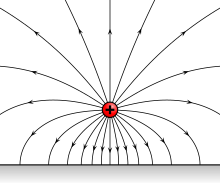
Field lines emanating from a positive charge above a plane conductor
An electric field generally varies in space,[55] and its strength at any one bespeak is defined every bit the force (per unit accuse) that would be felt by a stationary, negligible charge if placed at that signal.[22] : 469–70 The conceptual accuse, termed a 'test charge', must be vanishingly minor to foreclose its own electric field agonizing the main field and must also be stationary to preclude the effect of magnetic fields. As the electric field is defined in terms of force, and force is a vector, having both magnitude and management, so information technology follows that an electric field is a vector field.[22] : 469–70
The study of electric fields created by stationary charges is chosen electrostatics. The field may be visualised past a ready of imaginary lines whose direction at whatever point is the same every bit that of the field. This concept was introduced by Faraday,[56] whose term 'lines of forcefulness' still sometimes sees apply. The field lines are the paths that a point positive accuse would seek to make every bit it was forced to movement inside the field; they are however an imaginary concept with no physical existence, and the field permeates all the intervening infinite between the lines.[56] Field lines emanating from stationary charges take several key backdrop: first, that they originate at positive charges and terminate at negative charges; second, that they must enter whatsoever skilful conductor at right angles, and tertiary, that they may never cross nor close in on themselves.[22] : 479
A hollow conducting body carries all its accuse on its outer surface. The field is therefore 0 at all places inside the body.[41] : 88 This is the operating principal of the Faraday cage, a conducting metal crush which isolates its interior from outside electrical furnishings.
The principles of electrostatics are of import when designing items of high-voltage equipment. At that place is a finite limit to the electric field strength that may be withstood past whatsoever medium. Beyond this point, electrical breakup occurs and an electric arc causes flashover between the charged parts. Air, for example, tends to arc across small gaps at electric field strengths which exceed 30 kV per centimetre. Over larger gaps, its breakdown strength is weaker, maybe 1 kV per centimetre.[57] The nearly visible natural occurrence of this is lightning, caused when charge becomes separated in the clouds by rising columns of air, and raises the electrical field in the air to greater than it can withstand. The voltage of a big lightning cloud may be as high equally 100 MV and have discharge energies as swell as 250 kWh.[58]
The field strength is profoundly afflicted by nearby conducting objects, and it is particularly intense when information technology is forced to curve around sharply pointed objects. This principle is exploited in the lightning conductor, the sharp fasten of which acts to encourage the lightning stroke to develop there, rather than to the edifice information technology serves to protect[59] : 155
Electric potential
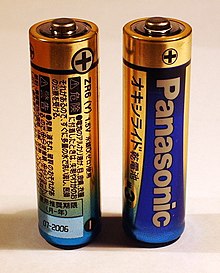
A pair of AA cells. The + sign indicates the polarity of the potential difference between the battery terminals.
The concept of electric potential is closely linked to that of the electric field. A small charge placed inside an electrical field experiences a forcefulness, and to have brought that accuse to that point confronting the force requires piece of work. The electric potential at any point is divers equally the energy required to bring a unit exam charge from an infinite altitude slowly to that point. Information technology is usually measured in volts, and 1 volt is the potential for which one joule of work must be expended to bring a charge of one coulomb from infinity.[22] : 494–98 This definition of potential, while formal, has little practical application, and a more useful concept is that of electrical potential difference, and is the energy required to move a unit charge between ii specified points. An electric field has the special property that information technology is bourgeois, which ways that the path taken by the test charge is irrelevant: all paths between two specified points expend the same free energy, and thus a unique value for potential difference may be stated.[22] : 494–98 The volt is then strongly identified as the unit of option for measurement and description of electric potential difference that the term voltage sees greater everyday usage.
For practical purposes, it is useful to define a common reference indicate to which potentials may exist expressed and compared. While this could be at infinity, a much more useful reference is the Earth itself, which is assumed to be at the same potential everywhere. This reference bespeak naturally takes the name earth or basis. Earth is causeless to exist an infinite source of equal amounts of positive and negative charge, and is therefore electrically uncharged—and unchargeable.[60]
Electric potential is a scalar quantity, that is, it has only magnitude and not direction. Information technology may be viewed as analogous to summit: just equally a released object will fall through a difference in heights caused past a gravitational field, then a accuse will 'autumn' across the voltage caused past an electric field.[61] Every bit relief maps show contour lines marking points of equal height, a fix of lines marking points of equal potential (known every bit equipotentials) may be drawn around an electrostatically charged object. The equipotentials cross all lines of force at correct angles. They must likewise prevarication parallel to a conductor's surface, otherwise this would produce a force that will motion the charge carriers to even the potential of the surface.
The electric field was formally defined as the force exerted per unit charge, but the concept of potential allows for a more useful and equivalent definition: the electric field is the local gradient of the electric potential. Unremarkably expressed in volts per metre, the vector direction of the field is the line of greatest slope of potential, and where the equipotentials lie closest together.[41] : 60
Electromagnets
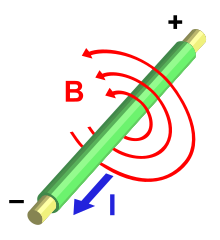
Magnetic field circles around a current
Ørsted's discovery in 1821 that a magnetic field existed around all sides of a wire carrying an electrical current indicated that at that place was a direct relationship between electricity and magnetism. Moreover, the interaction seemed different from gravitational and electrostatic forces, the two forces of nature and so known. The force on the compass needle did not direct information technology to or away from the electric current-carrying wire, just acted at right angles to information technology.[52] Ørsted'south words were that "the electric conflict acts in a revolving manner." The strength as well depended on the management of the current, for if the menstruum was reversed, then the forcefulness did also.[62]
Ørsted did not fully understand his discovery, but he observed the effect was reciprocal: a current exerts a force on a magnet, and a magnetic field exerts a force on a electric current. The phenomenon was further investigated by Ampère, who discovered that two parallel current-carrying wires exerted a forcefulness upon each other: 2 wires conducting currents in the same management are attracted to each other, while wires containing currents in opposite directions are forced apart.[63] The interaction is mediated by the magnetic field each electric current produces and forms the basis for the international definition of the ampere.[63]
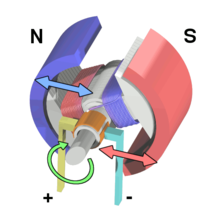
The electric motor exploits an of import effect of electromagnetism: a current through a magnetic field experiences a strength at right angles to both the field and current
This human relationship between magnetic fields and currents is extremely important, for it led to Michael Faraday'south invention of the electric motor in 1821. Faraday's homopolar motor consisted of a permanent magnet sitting in a pool of mercury. A current was allowed through a wire suspended from a pin above the magnet and dipped into the mercury. The magnet exerted a tangential strength on the wire, making it circumvolve around the magnet for every bit long as the current was maintained.[64]
Experimentation by Faraday in 1831 revealed that a wire moving perpendicular to a magnetic field developed a potential difference betwixt its ends. Further assay of this process, known as electromagnetic consecration, enabled him to land the principle, now known equally Faraday'southward police force of induction, that the potential divergence induced in a closed excursion is proportional to the rate of change of magnetic flux through the loop. Exploitation of this discovery enabled him to invent the first electrical generator in 1831, in which he converted the mechanical free energy of a rotating copper disc to electrical free energy.[64] Faraday'due south disc was inefficient and of no use as a applied generator, but it showed the possibility of generating electric ability using magnetism, a possibility that would be taken up by those that followed on from his work.
Electrochemistry
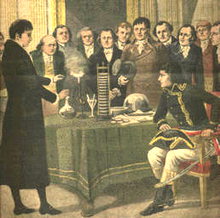
The ability of chemic reactions to produce electricity, and conversely the ability of electricity to drive chemical reactions has a wide array of uses.
Electrochemistry has always been an of import part of electricity. From the initial invention of the Voltaic pile, electrochemical cells take evolved into the many different types of batteries, electroplating and electrolysis cells. Aluminium is produced in vast quantities this way, and many portable devices are electrically powered using rechargeable cells.
Electric circuits

An electrical circuit is an interconnection of electric components such that electric charge is made to flow along a closed path (a circuit), usually to perform some useful task.
The components in an electric circuit can take many forms, which can include elements such as resistors, capacitors, switches, transformers and electronics. Electronic circuits contain active components, usually semiconductors, and typically showroom not-linear behaviour, requiring complex analysis. The simplest electrical components are those that are termed passive and linear: while they may temporarily store energy, they comprise no sources of it, and exhibit linear responses to stimuli.[65] : xv–sixteen
The resistor is peradventure the simplest of passive circuit elements: as its name suggests, it resists the current through it, dissipating its energy as heat. The resistance is a outcome of the movement of charge through a usher: in metals, for example, resistance is primarily due to collisions between electrons and ions. Ohm's law is a basic law of excursion theory, stating that the current passing through a resistance is straight proportional to the potential difference beyond it. The resistance of most materials is relatively constant over a range of temperatures and currents; materials under these atmospheric condition are known every bit 'ohmic'. The ohm, the unit of resistance, was named in laurels of Georg Ohm, and is symbolised past the Greek letter Ω. 1 Ω is the resistance that will produce a potential difference of 1 volt in response to a current of one amp.[65] : 30–35
The capacitor is a development of the Leyden jar and is a device that can shop charge, and thereby storing electric energy in the resulting field. Information technology consists of two conducting plates separated past a thin insulating dielectric layer; in do, thin metallic foils are coiled together, increasing the surface area per unit volume and therefore the capacitance. The unit of measurement of capacitance is the farad, named after Michael Faraday, and given the symbol F: one farad is the capacitance that develops a potential deviation of one volt when it stores a accuse of 1 coulomb. A capacitor continued to a voltage supply initially causes a current equally information technology accumulates accuse; this current volition however decay in fourth dimension every bit the capacitor fills, eventually falling to null. A capacitor volition therefore not permit a steady land current, but instead blocks information technology.[65] : 216–twenty
The inductor is a conductor, commonly a whorl of wire, that stores energy in a magnetic field in response to the current through information technology. When the current changes, the magnetic field does too, inducing a voltage betwixt the ends of the conductor. The induced voltage is proportional to the time rate of change of the current. The constant of proportionality is termed the inductance. The unit of inductance is the henry, named after Joseph Henry, a contemporary of Faraday. One henry is the inductance that volition induce a potential departure of one volt if the current through it changes at a rate of one ampere per 2nd. The inductor'due south behaviour is in some regards converse to that of the capacitor: it volition freely let an unchanging current, merely opposes a quickly changing one.[65] : 226–29
Electric power
Electric power is the rate at which electrical energy is transferred by an electric circuit. The SI unit of ability is the watt, one joule per second.
Electric ability, like mechanical ability, is the rate of doing work, measured in watts, and represented by the letter of the alphabet P. The term wattage is used colloquially to hateful "electrical power in watts." The electric power in watts produced past an electrical current I consisting of a charge of Q coulombs every t seconds passing through an electric potential (voltage) difference of V is
where
- Q is electrical charge in coulombs
- t is time in seconds
- I is electric current in amperes
- V is electrical potential or voltage in volts
Electricity generation is often washed past a process of converting mechanical energy to electricity. Devices such as steam turbines or gas turbines are involved in the production of the mechanical energy, which is passed on to electric generators which produce the electricity. Electricity can also be supplied by chemic sources such equally electrical batteries or by other means from a broad multifariousness of sources of energy. Electric ability is more often than not supplied to businesses and homes by the electric ability industry. Electricity is usually sold by the kilowatt hr (3.6 MJ) which is the production of power in kilowatts multiplied past running time in hours. Electric utilities mensurate power using electricity meters, which keep a running full of the electric energy delivered to a customer. Unlike fossil fuels, electricity is a low entropy form of free energy and tin be converted into motion or many other forms of energy with loftier efficiency.[66]
Electronics
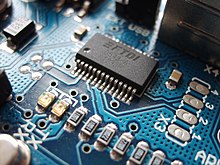
Electronics deals with electric circuits that involve active electric components such equally vacuum tubes, transistors, diodes, optoelectronics, sensors and integrated circuits, and associated passive interconnection technologies. The nonlinear behaviour of active components and their ability to control electron flows makes amplification of weak signals possible and electronics is widely used in information processing, telecommunications, and point processing. The ability of electronic devices to human action as switches makes digital information processing possible. Interconnection technologies such every bit excursion boards, electronics packaging technology, and other varied forms of communication infrastructure complete excursion functionality and transform the mixed components into a regular working arrangement.
Today, most electronic devices employ semiconductor components to perform electron command. The study of semiconductor devices and related technology is considered a branch of solid state physics, whereas the design and construction of electronic circuits to solve practical problems come nether electronics engineering.
Electromagnetic wave
Faraday'south and Ampère's piece of work showed that a time-varying magnetic field acted as a source of an electric field, and a time-varying electric field was a source of a magnetic field. Thus, when either field is changing in time, and so a field of the other is necessarily induced.[22] : 696–700 Such a phenomenon has the properties of a wave, and is naturally referred to as an electromagnetic wave. Electromagnetic waves were analysed theoretically by James Clerk Maxwell in 1864. Maxwell developed a set of equations that could unambiguously depict the interrelationship between electrical field, magnetic field, electric charge, and current. He could moreover prove that such a wave would necessarily travel at the speed of light, and thus light itself was a class of electromagnetic radiation. Maxwell's Laws, which unify light, fields, and charge are one of the slap-up milestones of theoretical physics.[22] : 696–700
Thus, the work of many researchers enabled the use of electronics to convert signals into high frequency aquiver currents, and via suitably shaped conductors, electricity permits the transmission and reception of these signals via radio waves over very long distances.
Production and uses
Generation and transmission

In the sixth century BC, the Greek philosopher Thales of Miletus experimented with bister rods and these experiments were the first studies into the production of electrical energy. While this method, now known as the triboelectric effect, tin can lift lite objects and generate sparks, it is extremely inefficient.[67] It was non until the invention of the voltaic pile in the eighteenth century that a viable source of electricity became bachelor. The voltaic pile, and its modern descendant, the electrical battery, store energy chemically and make it available on demand in the class of electrical free energy.[67] The bombardment is a versatile and very common power source which is ideally suited to many applications, merely its energy storage is finite, and once discharged it must be tending of or recharged. For large electrical demands electric energy must exist generated and transmitted continuously over conductive manual lines.
Electrical power is commonly generated by electro-mechanical generators driven by steam produced from fossil fuel combustion, or the heat released from nuclear reactions; or from other sources such as kinetic energy extracted from wind or flowing water. The modern steam turbine invented by Sir Charles Parsons in 1884 today generates about lxxx percent of the electric ability in the earth using a variety of heat sources. Such generators bear no resemblance to Faraday'southward homopolar disc generator of 1831, simply they all the same rely on his electromagnetic principle that a conductor linking a changing magnetic field induces a potential difference across its ends.[68] The invention in the late nineteenth century of the transformer meant that electrical power could be transmitted more efficiently at a college voltage but lower current. Efficient electrical transmission meant in turn that electricity could be generated at centralised ability stations, where it benefited from economies of scale, and and then exist despatched relatively long distances to where it was needed.[69] [70]

Wind ability is of increasing importance in many countries
Since electric free energy cannot easily be stored in quantities large enough to meet demands on a national calibration, at all times exactly as much must be produced as is required.[69] This requires electricity utilities to make careful predictions of their electric loads, and maintain abiding co-ordination with their ability stations. A certain amount of generation must always be held in reserve to cushion an electrical grid against inevitable disturbances and losses.
Need for electricity grows with great rapidity every bit a nation modernises and its economic system develops.[71] The Usa showed a 12% increment in need during each year of the first three decades of the twentieth century,[72] a rate of growth that is now being experienced by emerging economies such as those of India or Red china.[73] [74] Historically, the growth charge per unit for electricity demand has outstripped that for other forms of free energy.[75] : 16
Environmental concerns with electricity generation take led to an increased focus on generation from renewable sources, in particular from wind and solar. While debate can be expected to continue over the environmental impact of different means of electricity product, its last form is relatively clean.[75] : 89
Applications

Electricity is a very convenient way to transfer free energy, and it has been adjusted to a huge, and growing, number of uses.[76] The invention of a practical incandescent light bulb in the 1870s led to lighting becoming one of the first publicly available applications of electrical ability. Although electrification brought with it its own dangers, replacing the naked flames of gas lighting greatly reduced fire hazards inside homes and factories.[77] Public utilities were set upward in many cities targeting the burgeoning market for electrical lighting. In the late 20th century and in modern times, the tendency has started to flow in the direction of deregulation in the electrical power sector.[78]
The resistive Joule heating outcome employed in filament low-cal bulbs also sees more direct use in electrical heating. While this is versatile and controllable, it can be seen as wasteful, since well-nigh electric generation has already required the production of heat at a ability station.[79] A number of countries, such every bit Denmark, take issued legislation restricting or banning the employ of resistive electric heating in new buildings.[80] Electricity is still nonetheless a highly practical energy source for heating and refrigeration,[81] with air conditioning/heat pumps representing a growing sector for electricity need for heating and cooling, the furnishings of which electricity utilities are increasingly obliged to adjust.[82]
Electricity is used within telecommunication, and indeed the electrical telegraph, demonstrated commercially in 1837 by Cooke and Wheatstone, was one of its primeval applications. With the construction of first transcontinental, and so transatlantic, telegraph systems in the 1860s, electricity had enabled communications in minutes across the world. Optical fibre and satellite communication have taken a share of the market for communications systems, but electricity tin can exist expected to remain an essential part of the process.
The effects of electromagnetism are near visibly employed in the electrical motor, which provides a clean and efficient means of motive power. A stationary motor such every bit a winch is easily provided with a supply of ability, but a motor that moves with its awarding, such as an electric vehicle, is obliged to either comport along a power source such every bit a battery, or to collect current from a sliding contact such as a pantograph. Electrically powered vehicles are used in public transportation, such as electric buses and trains,[83] and an increasing number of battery-powered electric cars in private buying.
Electronic devices make use of the transistor, peradventure one of the most of import inventions of the twentieth century,[84] and a fundamental building block of all modernistic circuitry. A modern integrated excursion may incorporate many billions of miniaturised transistors in a region only a few centimetres foursquare.[85]
Electricity and the natural earth
Physiological effects
A voltage applied to a human body causes an electric electric current through the tissues, and although the relationship is non-linear, the greater the voltage, the greater the current.[86] The threshold for perception varies with the supply frequency and with the path of the current, but is about 0.1 mA to ane mA for mains-frequency electricity, though a current as low as a microamp can be detected as an electrovibration effect under sure conditions.[87] If the current is sufficiently loftier, it will cause musculus wrinkle, fibrillation of the heart, and tissue burns.[86] The lack of any visible sign that a conductor is electrified makes electricity a particular chance. The pain caused past an electric shock tin be intense, leading electricity at times to exist employed as a method of torture. Death caused by an electric shock is referred to as electrocution. Electrocution is still the means of judicial execution in some jurisdictions, though its use has get rarer in recent times.[88]
Electrical phenomena in nature
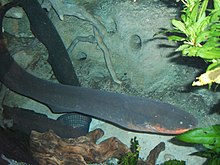
Electricity is not a human being invention, and may be observed in several forms in nature, a prominent manifestation of which is lightning. Many interactions familiar at the macroscopic level, such as touch on, friction or chemical bonding, are due to interactions between electric fields on the atomic scale. The Earth's magnetic field is thought to arise from a natural dynamo of circulating currents in the planet'southward core.[89] Sure crystals, such as quartz, or fifty-fifty sugar, generate a potential difference across their faces when subjected to external pressure.[90] This phenomenon is known as piezoelectricity, from the Greek piezein (πιέζειν), meaning to press, and was discovered in 1880 past Pierre and Jacques Curie. The effect is reciprocal, and when a piezoelectric fabric is subjected to an electric field, a modest change in concrete dimensions takes place.[ninety]
§Bioelectrogenesis in microbial life is a prominent phenomenon in soils and sediment ecology resulting from anaerobic respiration. The microbial fuel cell mimics this ubiquitous natural miracle.
Some organisms, such as sharks, are able to discover and respond to changes in electric fields, an power known as electroreception,[91] while others, termed electrogenic, are able to generate voltages themselves to serve every bit a predatory or defensive weapon; these are electric fish in different orders.[iii] The order Gymnotiformes, of which the best known example is the electric eel, detect or stun their prey via high voltages generated from modified muscle cells called electrocytes.[3] [4] All animals transmit information along their cell membranes with voltage pulses called action potentials, whose functions include communication by the nervous system between neurons and muscles.[92] An electric shock stimulates this organization, and causes muscles to contract.[93] Activity potentials are also responsible for coordinating activities in certain plants.[92]
Cultural perception
In 1850, William Gladstone asked the scientist Michael Faraday why electricity was valuable. Faraday answered, "One day sir, you may tax it."[94]
In the 19th and early 20th century, electricity was not part of the everyday life of many people, even in the industrialised Western world. The pop culture of the fourth dimension accordingly often depicted it as a mysterious, quasi-magical force that can slay the living, revive the dead or otherwise bend the laws of nature.[95] This mental attitude began with the 1771 experiments of Luigi Galvani in which the legs of dead frogs were shown to twitch on application of animal electricity. "Revitalization" or resuscitation of apparently dead or drowned persons was reported in the medical literature shortly after Galvani's work. These results were known to Mary Shelley when she authored Frankenstein (1819), although she does not name the method of revitalization of the monster. The revitalization of monsters with electricity later became a stock theme in horror films.
As the public familiarity with electricity as the lifeblood of the Second Industrial Revolution grew, its wielders were more frequently cast in a positive lite,[96] such every bit the workers who "finger decease at their gloves' end as they piece and repiece the living wires" in Rudyard Kipling's 1907 verse form Sons of Martha.[96] Electrically powered vehicles of every sort featured large in take chances stories such as those of Jules Verne and the Tom Swift books.[96] The masters of electricity, whether fictional or real—including scientists such as Thomas Edison, Charles Steinmetz or Nikola Tesla—were popularly conceived of equally having wizard-like powers.[96]
With electricity ceasing to exist a novelty and becoming a necessity of everyday life in the later half of the 20th century, it required particular attention by popular culture only when information technology stops flowing,[96] an event that usually signals disaster.[96] The people who go along it flowing, such every bit the nameless hero of Jimmy Webb'south vocal "Wichita Lineman" (1968),[96] are still oft cast as heroic, wizard-like figures.[96]
See also
- Ampère's circuital police, connects the direction of an electric current and its associated magnetic currents.
- Electric potential free energy, the potential energy of a arrangement of charges
- Electricity marketplace, the sale of electrical energy
- Etymology of electricity, the origin of the word electricity and its electric current different usages
- Hydraulic analogy, an analogy between the menses of water and electric electric current
Notes
- ^ Jones, D.A. (1991), "Electrical engineering science: the courage of club", IEE Proceedings A - Science, Measurement and Engineering, 138 (1): 1–x, doi:10.1049/ip-a-3.1991.0001
- ^ Moller, Peter; Kramer, Bernd (Dec 1991), "Review: Electrical Fish", BioScience, American Found of Biological Sciences, 41 (11): 794–96 [794], doi:x.2307/1311732, JSTOR 1311732
- ^ a b c Bullock, Theodore H. (2005), Electroreception, Springer, pp. 5–7, ISBN0-387-23192-seven
- ^ a b Morris, Simon C. (2003), Life'due south Solution: Inevitable Humans in a Lonely Universe, Cambridge University Press, pp. 182–85, ISBN0-521-82704-3
- ^ a b Stewart, Joseph (2001), Intermediate Electromagnetic Theory, Earth Scientific, p. 50, ISBN981-02-4471-1
- ^ Simpson, Brian (2003), Electrical Stimulation and the Relief of Pain, Elsevier Health Sciences, pp. half-dozen–seven, ISBN0-444-51258-6
- ^ Diogenes Laertius. R.D. Hicks (ed.). "Lives of Eminent Philosophers, Book 1 Chapter 1 [24]". Perseus Digital Library. Tufts Academy. Archived from the original on 30 July 2022. Retrieved 5 February 2017.
Aristotle and Hippias affirm that, arguing from the magnet and from bister, he attributed a soul or life even to inanimate objects.
- ^ Aristotle. Daniel C. Stevenson (ed.). "De Animus (On the Soul) Book 1 Office 2 (B4 verso)". The Net Classics Annal. Translated past J.A. Smith. Archived from the original on 26 Feb 2017. Retrieved 5 February 2017.
Thales, too, to judge from what is recorded about him, seems to have held soul to be a motive forcefulness, since he said that the magnet has a soul in it considering it moves the iron.
- ^ Frood, Arran (27 February 2003), Riddle of 'Baghdad's batteries' , BBC, archived from the original on 2017-09-03, retrieved 2008-02-16
- ^ Baigrie, Brian (2007), Electricity and Magnetism: A Historical Perspective, Greenwood Printing, pp. 7–viii, ISBN978-0-313-33358-3
- ^ Chalmers, Gordon (1937), "The Lodestone and the Understanding of Matter in Seventeenth Century England", Philosophy of Science, four (1): 75–95, doi:x.1086/286445, S2CID 121067746
- ^ a b c Guarnieri, M. (2014). "Electricity in the age of Enlightenment". IEEE Industrial Electronics Mag. viii (iii): 60–63. doi:10.1109/MIE.2014.2335431. S2CID 34246664.
- ^ Srodes, James (2002), Franklin: The Essential Founding Male parent, Regnery Publishing, pp. 92–94, ISBN0-89526-163-four Information technology is uncertain if Franklin personally carried out this experiment, just information technology is popularly attributed to him.
- ^ Uman, Martin (1987), All About Lightning (PDF), Dover Publications, ISBN0-486-25237-X
- ^ Riskin, Jessica (1998), Poor Richard's Leyden Jar: Electricity and economy in Franklinist France (PDF), p. 327, archived (PDF) from the original on 2014-05-12, retrieved 2014-05-11
- ^ Williamson, Hugh (1775). "Experiments and observations on the Gymnotus electricus, or electrical eel". Philosophical Transactions of the Royal Society. 65 (65): 94–101. doi:10.1098/rstl.1775.0011. S2CID 186211272. Archived from the original on 2022-07-thirty. Retrieved 2022-07-xvi .
- ^ Edwards, Paul J. (2021). "A Correction to the Record of Early Electrophysiology Research on the 250th Anniversary of a Historic Trek to Île de Ré."
- ^ Hunter, John (1775). "An business relationship of the Gymnotus electricus". Philosophical Transactions of the Regal Society of London (65): 395–407.
- ^ a b Guarnieri, M. (2014). "The Big Spring from the Legs of a Frog". IEEE Industrial Electronics Magazine. 8 (4): 59–61, 69. doi:ten.1109/MIE.2014.2361237. S2CID 39105914.
- ^ a b c Kirby, Richard Southward. (1990), Applied science in History, Courier Dover Publications, pp. 331–33, ISBN0-486-26412-2
- ^ Berkson, William (1974) Fields of forcefulness: the development of a world view from Faraday to Einstein p.148. Routledge, 1974
- ^ a b c d due east f g h i j Sears, Francis; et al. (1982), Academy Physics, Sixth Edition, Addison Wesley, ISBN0-201-07199-ane
- ^ Hertz, Heinrich (1887). "Ueber den Einfluss des ultravioletten Lichtes auf die electrische Entladung". Annalen der Physik. 267 (viii): S. 983–1000. Bibcode:1887AnP...267..983H. doi:10.1002/andp.18872670827. Archived from the original on 2020-06-11. Retrieved 2019-08-25 .
- ^ "The Nobel Prize in Physics 1921". Nobel Foundation. Archived from the original on 2008-10-17. Retrieved 2013-03-sixteen .
- ^ "Solid country" Archived 2018-07-21 at the Wayback Machine, The Complimentary Lexicon
- ^ John Sydney Blakemore, Solid state physics, pp. 1–three, Cambridge University Press, 1985 ISBN 0-521-31391-0.
- ^ Richard C. Jaeger, Travis Northward. Blalock, Microelectronic circuit design, pp. 46–47, McGraw-Hill Professional, 2003 ISBN 0-07-250503-6.
- ^ "1947: Invention of the Point-Contact Transistor". Estimator History Museum. Archived from the original on thirty September 2021. Retrieved x August 2019.
- ^ "1948: Conception of the Junction Transistor". The Silicon Engine. Computer History Museum. Archived from the original on 30 July 2020. Retrieved 8 October 2019.
- ^ a b Moskowitz, Sanford L. (2016). Avant-garde Materials Innovation: Managing Global Technology in the 21st century. John Wiley & Sons. ISBN9780470508923. Archived from the original on 2020-eleven-05. Retrieved 2019-ten-26 .
- ^ "1960 - Metal Oxide Semiconductor (MOS) Transistor Demonstrated". The Silicon Engine. Computer History Museum. Archived from the original on 2019-10-27. Retrieved 2019-10-26 .
- ^ a b "Who Invented the Transistor?". Computer History Museum. 4 December 2013. Archived from the original on 13 December 2013. Retrieved xx July 2019.
- ^ "Triumph of the MOS Transistor". YouTube. Computer History Museum. 6 August 2010. Archived from the original on 2021-10-28. Retrieved 21 July 2019.
- ^ Feldman, Leonard C. (2001). "Introduction". Key Aspects of Silicon Oxidation. Springer Science & Business organization Media. pp. ane–11. ISBN9783540416821. Archived from the original on 2019-12-25. Retrieved 2019-10-26 .
- ^ Golio, Mike; Golio, Janet (2018). RF and Microwave Passive and Active Technologies. CRC Press. pp. 18–2. ISBN9781420006728. Archived from the original on 2020-11-04. Retrieved 2019-10-26 .
- ^ "13 Sextillion & Counting: The Long & Winding Road to the Virtually Ofttimes Manufactured Human Artifact in History". Computer History Museum. April two, 2018. Archived from the original on 28 July 2019. Retrieved 28 July 2019.
- ^ Shirriff, Ken (thirty August 2016). "The Surprising Story of the Offset Microprocessors". IEEE Spectrum. Constitute of Electric and Electronics Engineers. 53 (9): 48–54. doi:10.1109/MSPEC.2016.7551353. S2CID 32003640. Archived from the original on 12 July 2021. Retrieved 13 October 2019.
- ^ "The MOS Memory Marketplace" (PDF). Integrated Circuit Engineering science Corporation. Smithsonian Institution. 1997. Archived (PDF) from the original on 26 June 2011. Retrieved 16 Oct 2019.
- ^ "MOS Retentiveness Market place Trends" (PDF). Integrated Excursion Engineering Corporation. Smithsonian Institution. 1998. Archived (PDF) from the original on 16 Oct 2019. Retrieved xvi Oct 2019.
- ^ "The repulsive force betwixt 2 minor spheres charged with the same type of electricity is inversely proportional to the foursquare of the distance between the centres of the two spheres." Charles-Augustin de Coulomb, Histoire de l'Academie Royal des Sciences, Paris 1785.
- ^ a b c d e f k Duffin, W.J. (1980), Electricity and Magnetism, 3rd edition, McGraw-Hill, ISBN0-07-084111-X
- ^ National Research Quango (1998), Physics Through the 1990s, National Academies Press, pp. 215–16, ISBN0-309-03576-7
- ^ a b Umashankar, Korada (1989), Introduction to Engineering Electromagnetic Fields, World Scientific, pp. 77–79, ISBN9971-5-0921-0
- ^ a b Hawking, Stephen (1988), A Cursory History of Time, Runted Press, p. 77, ISBN0-553-17521-1
- ^ Trefil, James (2003), The Nature of Science: An A–Z Guide to the Laws and Principles Governing Our Universe, Houghton Mifflin Books, p. 74, ISBN0-618-31938-7
- ^ Shectman, Jonathan (2003), Groundbreaking Scientific Experiments, Inventions, and Discoveries of the 18th Century, Greenwood Press, pp. 87–91, ISBN0-313-32015-2
- ^ Sewell, Tyson (1902), The Elements of Electrical Engineering, Lockwood, p. xviii . The Q originally stood for 'quantity of electricity', the term 'electricity' now more than unremarkably expressed equally 'charge'.
- ^ Close, Frank (2007), The New Cosmic Onion: Quarks and the Nature of the Universe, CRC Press, p. 51, ISBN978-1-58488-798-0
- ^ Shock and Awe: The Story of Electricity – Jim Al-Khalili BBC Horizon
- ^ Ward, Robert (1960), Introduction to Electrical Engineering, Prentice-Hall, p. 18
- ^ Solymar, L. (1984), Lectures on electromagnetic theory, Oxford University Press, p. 140, ISBN0-nineteen-856169-5
- ^ a b Berkson, William (1974), Fields of Force: The Development of a World View from Faraday to Einstein, Routledge, p. 370, ISBN0-7100-7626-6 Accounts differ equally to whether this was before, during, or after a lecture.
- ^ "Lab Note #105 EMI Reduction – Unsuppressed vs. Suppressed". Arc Suppression Technologies. April 2011. Archived from the original on March 5, 2016. Retrieved March 7, 2012.
- ^ a b c Bird, John (2007), Electric and Electronic Principles and Engineering science, 3rd edition, Newnes, ISBN9781417505432
- ^ Almost all electrical fields vary in space. An exception is the electric field surrounding a planar usher of infinite extent, the field of which is compatible.
- ^ a b Morely & Hughes (1970), Principles of Electricity, Fifth edition, p. 73, ISBN0-582-42629-four
- ^ Naidu, M.South.; Kamataru, Five. (1982), High Voltage Engineering, Tata McGraw-Hill, p. 2, ISBN0-07-451786-iv
- ^ Naidu, M.S.; Kamataru, 5. (1982), High Voltage Engineering, Tata McGraw-Loma, pp. 201–02, ISBN0-07-451786-4
- ^ Paul J. Nahin (ix Oct 2002). Oliver Heaviside: The Life, Work, and Times of an Electrical Genius of the Victorian Age. JHU Press. ISBN978-0-8018-6909-nine.
- ^ Serway, Raymond A. (2006), Serway'due south Higher Physics, Thomson Brooks, p. 500, ISBN0-534-99724-four
- ^ Saeli, Sue; MacIsaac, Dan (2007), "Using Gravitational Analogies To Introduce Simple Electric Field Theory Concepts", The Physics Teacher, 45 (2): 104, Bibcode:2007PhTea..45..104S, doi:10.1119/i.2432088, archived from the original on 2008-02-sixteen, retrieved 2007-12-09
- ^ Thompson, Silvanus P. (2004), Michael Faraday: His Life and Work, Elibron Classics, p. 79, ISBN1-4212-7387-10
- ^ a b Morely & Hughes, Principles of Electricity, 5th edition, pp. 92–93
- ^ a b Institution of Engineering and Technology, Michael Faraday: Biography, archived from the original on 2007-07-03, retrieved 2007-12-09
- ^ a b c d Alexander, Charles; Sadiku, Matthew (2006), Fundamentals of Electric Circuits (3, revised ed.), McGraw-Colina, ISBN9780073301150
- ^ Ecology Physics Past Clare Smith 2001
- ^ a b Dell, Ronald; Rand, David (2001), "Agreement Batteries", NASA Sti/Recon Technical Report N, Purple Society of Chemical science, 86: 2–4, Bibcode:1985STIN...8619754M, ISBN0-85404-605-4
- ^ McLaren, Peter G. (1984), Elementary Electric Power and Machines, Ellis Horwood, pp. 182–83, ISBN0-85312-269-5
- ^ a b Patterson, Walter C. (1999), Transforming Electricity: The Coming Generation of Change, Earthscan, pp. 44–48, ISBNi-85383-341-X
- ^ Edison Electric Institute, History of the Electric Ability Industry, archived from the original on Nov xiii, 2007, retrieved 2007-12-08
- ^ Bryce, Robert (2020). A Question of Power: Electricity and the Wealth of Nations. PublicAffairs. p. 352. ISBN978-1610397490. Archived from the original on 2021-11-07. Retrieved 2021-11-07 .
- ^ Edison Electrical Institute, History of the U.S. Electric Power Industry, 1882–1991, archived from the original on 2010-12-06, retrieved 2007-12-08
- ^ Carbon Sequestration Leadership Forum, An Energy Summary of India, archived from the original on 2007-12-05, retrieved 2007-12-08
- ^ IndexMundi, China Electricity – consumption, archived from the original on 2019-06-17, retrieved 2007-12-08
- ^ a b National Research Council (1986), Electricity in Economic Growth, National Academies Printing, ISBN0-309-03677-1
- ^ Wald, Matthew (21 March 1990), "Growing Employ of Electricity Raises Questions on Supply", New York Times, archived from the original on 2008-01-08, retrieved 2007-12-09
- ^ d'Alroy Jones, Peter, The Consumer Society: A History of American Capitalism, Penguin Books, p. 211
- ^ "The Bumpy Road to Free energy Deregulation". EnPowered. 2016-03-28. Archived from the original on 2017-04-07. Retrieved 2017-05-29 .
- ^ ReVelle, Charles and Penelope (1992), The Global Surround: Securing a Sustainable Hereafter, Jones & Bartlett, p. 298, ISBN0-86720-321-8
- ^ Danish Ministry building of Environment and Energy, "F.ii The Oestrus Supply Act", Kingdom of denmark's 2d National Communication on Climate Change, archived from the original on January viii, 2008, retrieved 2007-12-09
- ^ Brownish, Charles E. (2002), Ability resources, Springer, ISBN3-540-42634-5
- ^ Hojjati, B.; Battles, S., The Growth in Electricity Demand in U.S. Households, 1981–2001: Implications for Carbon Emissions (PDF), archived from the original (PDF) on 2008-02-16, retrieved 2007-12-09
- ^ "Public Transportation", Alternative Energy News, 2010-03-10, archived from the original on 2010-12-04, retrieved 2010-12-02
- ^ Herrick, Dennis F. (2003), Media Management in the Age of Giants: Business Dynamics of Journalism , Blackwell Publishing, ISBN0-8138-1699-8
- ^ Das, Saswato R. (2007-12-fifteen), "The tiny, mighty transistor", Los Angeles Times, archived from the original on 2008-x-11, retrieved 2008-01-12
- ^ a b Tleis, Nasser (2008), Ability System Modelling and Fault Analysis, Elsevier, pp. 552–54, ISBN978-0-7506-8074-5
- ^ Grimnes, Sverre (2000), Bioimpedance and Bioelectricity Bones, Academic Printing, pp. 301–09, ISBN0-12-303260-one
- ^ Lipschultz, J.H.; Hilt, M.L.J.H. (2002), Crime and Local Television News, Lawrence Erlbaum Assembly, p. 95, ISBN0-8058-3620-9
- ^ Encrenaz, Thérèse (2004), The Solar System, Springer, p. 217, ISBNiii-540-00241-3
- ^ a b Lima-de-Faria, José; Buerger, Martin J. (1990), "Historical Atlas of Crystallography", Zeitschrift für Kristallographie, Springer, 209 (12): 67, Bibcode:1994ZK....209.1008P, doi:10.1524/zkri.1994.209.12.1008a, ISBN0-7923-0649-10
- ^ Ivancevic, Vladimir & Tijana (2005), Natural Biodynamics, World Scientific, p. 602, ISBN981-256-534-5
- ^ a b Kandel, E.; Schwartz, J.; Jessell, T. (2000), Principles of Neural Scientific discipline, McGraw-Hill Professional, pp. 27–28, ISBN0-8385-7701-6
- ^ Davidovits, Paul (2007), Physics in Biology and Medicine, Academic Printing, pp. 204–05, ISBN978-0-12-369411-9
- ^ Jackson, Mark (4 Nov 2013), Theoretical physics – like sex, but with no need to experiment, The Conversation, archived from the original on iv April 2014, retrieved 26 March 2014
- ^ Van Riper, A. Bowdoin (2002), Science in popular civilisation: a reference guide, Westport: Greenwood Printing, p. 69, ISBN0-313-31822-0
- ^ a b c d e f grand h Van Riper, op.cit., p. 71.
References
- Benjamin, Park (1898). A history of electricity: (The intellectual rise in electricity) from antiquity to the days of Benjamin Franklin. New York: J. Wiley & Sons.
- Hammond, Percy (1981), "Electromagnetism for Engineers", Nature, Pergamon, 168 (4262): iv–5, Bibcode:1951Natur.168....4G, doi:10.1038/168004b0, ISBN0-08-022104-1, S2CID 27576009
- Morely, A.; Hughes, E. (1994), Principles of Electricity (5th ed.), Longman, ISBN0-582-22874-3
- Nahvi, Mahmood; Joseph, Edminister (1965), Electric Circuits, McGraw-Hill, ISBN9780071422413
- Naidu, 1000.Southward.; Kamataru, V. (1982), High Voltage Engineering, Tata McGraw-Hill, ISBN0-07-451786-4
- Nilsson, James; Riedel, Susan (2007), Electric Circuits, Prentice Hall, ISBN978-0-xiii-198925-2
- Patterson, Walter C. (1999), Transforming Electricity: The Coming Generation of Alter, Earthscan, ISBNone-85383-341-X
External links
![]()
Look up electricity in Wiktionary, the gratis dictionary.
- Basic Concepts of Electricity chapter from Lessons In Electric Circuits Vol 1 DC book and series.
- "1-Hundred Years of Electricity", May 1931, Pop Mechanics
- Illustrated view of how an American dwelling house'due south electrical system works
- Electricity around the world
- Electricity Misconceptions
- Electricity and Magnetism
- Understanding Electricity and Electronics in well-nigh 10 Minutes
- World Bank study on H2o, Electricity and Utility subsidies
Distance Between Atlanta & Savannah,
Source: https://en.wikipedia.org/wiki/Electricity
Posted by: daviswillith1981.blogspot.com



0 Response to "Distance Between Atlanta & Savannah"
Post a Comment